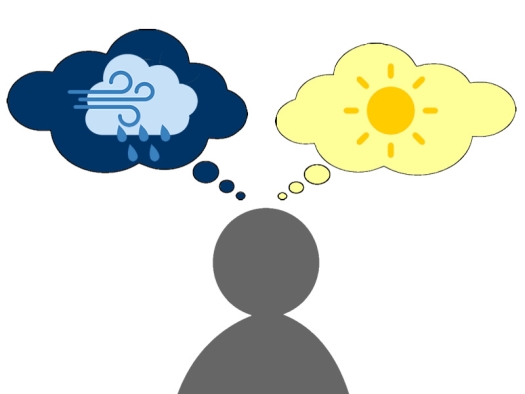PositiveNegativeThoughts.jpg

Illustration by FAIM with weather icons by inspire-studio / Pixabay License
Over the years, I’ve recognized that intention is not just for healing illness or manifesting a new car.
It’s about creating deliberate intentional thoughts in everything you do and every way you behave in the world.
We all know that thinking negative thoughts about ourselves is harmful. For instance, research from the Center for Advanced Wound Care in Reading in Pennsylvania has discovered that patients with slow-healing wounds often have negative thought patterns.
But these thoughts and intentions also have a massive effect on our relationships. Recent research has showed that even the stress of reliving an argument can delay wound healing in our significant others by at least a day.
In a study by the Ohio State University College of Medicine, the researchers gathered together 42 married couples. A tiny puncture device was used to inflict a small wound on one member of each couple. During that process, the partners were asked to hold a constructive discussion without conflict. The healing of the wound was carefully timed over a number of days.
Several months later, the researchers asked the couples to return for a second experiment. This time the pairs were told to discuss an ongoing contentious issue, such as money or in-laws, while the same injury from the puncture device was inflicted.
The researchers discovered that these second wounds took a day longer to heal than the earlier wounds had. The more incompatible the couples, the slower the wound healing; members of the most hostile couples healed at 60 percent of the rate of those with more compatible partners.
Examination of the fluids in the wounds also found different levels of a chemical called interleukin-6 (IL-6), a cytokine and key chemical in the immune system. Among the hostile couples, wounds had levels of interleukin-6 that were too low initially and then too high after an argument, as if the immune system had been overwhelmed.
Think about what you are thinking about other people in your circle. Does a negative thought about someone else become a self-fulfilling prophecy?
What about those moments when you feel an aversion to someone or something that you cannot explain rationally? Are you picking up their negative intention? Are the thoughts of pessimists more powerful than those of optimists?
Carroll Nash, the director of the parapsychology department at St Joseph’s University in Philadelphia, once carried out an intriguing study of microbes, which has a big implication for human beings.
Escherichia coli ordinarily is a friend to every warm-blooded living thing. Millions of these bacteria, which are responsible for digesting food, reside peacefully in our gut. Up to 10 trillion E coli microbes get passed with every ordinary human bowel movement.
E coli also ferment lactose, the enzyme present in milk, and are responsible for the fact that people who can’t digest milk make gas.
It’s when E coli migrates out of the digestive tract that problems occur: cystitis (say, if it travels to the urinary tract) or the potentially fatal inflammation peritonitis (if it makes its way to the abdominal cavity).
As with many microbes, E coli can suddenly turn unfriendly by mutating into a virulent form, which ejects toxins that stimulate the lining of the intestines, causing diarrhea, fever and abdominal cramps.
E coli represented an interesting choice for Nash. If humans could control the growth of this organism, they might avoid serious E coli infection and improve digestive health in general.
Nash decided to test whether mental influence could affect the mutation rates of this bacteria. Ordinarily, E coli starts life unable to ferment lactose (and so is ‘lactose-negative’), but eventually mutates and can do so (at which point it becomes ‘lactose positive’). This process ordinarily proceeds predictably, at a recognized rate.
Nash wanted to see whether his volunteers could slow down or speed up that process. To work out the growth rates of such tiny organisms, he employed an electrophotometer, which counted the microbes by measuring the slightest differences in the density of suspension media.
Each of his student experimenters was given nine test tubes containing both lactose-negative and lactose-positive strains of E coli culture. In the first three test tubes, the students were asked to mentally encourage the mutation of the bacteria from lactose-negative to lactose-positive.
For the next three they were asked to attempt to inhibit this process. The final three, the controls, would not be exposed to influence of any kind.
When he tallied the results, Nash discovered more mutation than normal in the test tubes that had received the ‘positive’ intentions to mutate, and fewer than normal in those in which the intention was to attempt to inhibit the process. The greatest effect occurred with negative intention.
The mutation process of E coli had been severely disrupted by negative thoughts.
Researchers at the National Yang Ming Medical College and National Research Institute of Chinese Medicine in Taipei, Taiwan carried out a similar study of positive and negative intention, this time on human cells.
A Qigong master alternatively sent positive and negative intention on boar sperm cells and human fibroblast cells, which make up the connective tissue of the body.
After two minutes of negative intention, the growth and respiration rates, and DNA and protein synthesis of the cells decreased dramatically by between 22 and 53 percent.
When the Qigong master reversed his intention and send 10 minutes of positive intention, all the activity of the cell increased by 5 to 28 percent.
All these studies are powerful demonstrations that we have to become far more mindful of intentions at every moment of our lives.
Every move you make, every breath you take, and most importantly, every thought you have, all become part of an intentional relationship.
For more information, visit Lynne McTaggart's website.
Wounds That Cut Deep was originally published on Lynne McTaggart's website, July 29, 2022. Used with permission.


